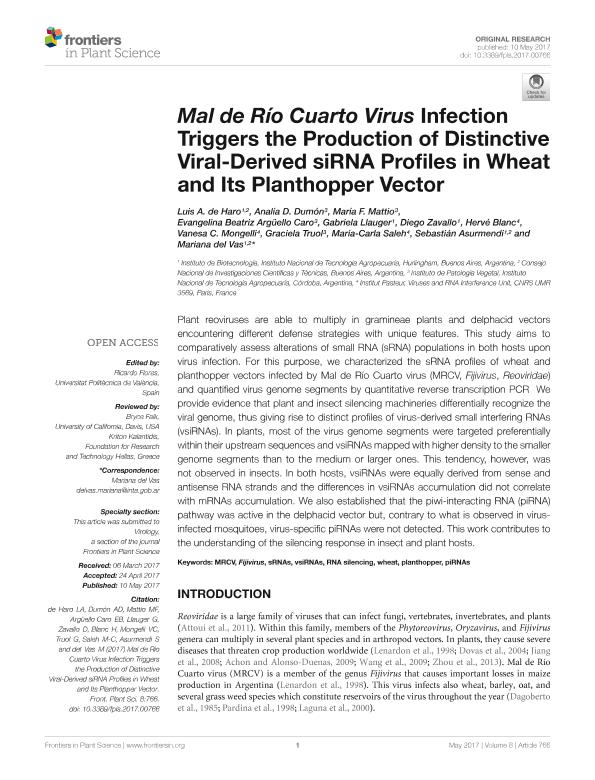Mostrar el registro sencillo del ítem
dc.contributor.author
de Haro, Luis Alejandro

dc.contributor.author
Dumón, Analía Delina

dc.contributor.author
Mattio, Maria Fernanda

dc.contributor.author
Argüello Caro, Evangelina Beatriz

dc.contributor.author
Llauger, Gabriela

dc.contributor.author
Zavallo, Diego

dc.contributor.author
Blanc, Hervé
dc.contributor.author
Mongelli, Vanesa Claudia

dc.contributor.author
Truol, Graciela Ana

dc.contributor.author
Saleh, María Carla
dc.contributor.author
Asurmendi, Sebastian

dc.contributor.author
del Vas, Mariana

dc.date.available
2019-03-29T19:11:44Z
dc.date.issued
2017-05
dc.identifier.citation
de Haro, Luis Alejandro; Dumón, Analía Delina; Mattio, Maria Fernanda; Argüello Caro, Evangelina Beatriz; Llauger, Gabriela; et al.; Mal de Río Cuarto virus infection triggers the production of distinctive viral-derived siRNA profiles in wheat and its planthopper vector; Frontiers Research Foundation; Frontiers in Plant Science; 8; 5-2017; 1-11
dc.identifier.issn
1664-462X
dc.identifier.uri
http://hdl.handle.net/11336/72863
dc.description.abstract
Plant reoviruses are able to multiply in gramineae plants and delphacid vectors encountering different defense strategies with unique features. This study aims to comparatively assess alterations of small RNA (sRNA) populations in both hosts upon virus infection. For this purpose, we characterized the sRNA profiles of wheat and planthopper vectors infected by Mal de Río Cuarto virus (MRCV, Fijivirus, Reoviridae) and quantified virus genome segments by quantitative reverse transcription PCR We provide evidence that plant and insect silencing machineries differentially recognize the viral genome, thus giving rise to distinct profiles of virus-derived small interfering RNAs (vsiRNAs). In plants, most of the virus genome segments were targeted preferentially within their upstream sequences and vsiRNAs mapped with higher density to the smaller genome segments than to the medium or larger ones. This tendency, however, was not observed in insects. In both hosts, vsiRNAs were equally derived from sense and antisense RNA strands and the differences in vsiRNAs accumulation did not correlate with mRNAs accumulation. We also established that the piwi-interacting RNA (piRNA) pathway was active in the delphacid vector but, contrary to what is observed in virus-infected mosquitoes, virus-specific piRNAs were not detected. This work contributes to the understanding of the silencing response in insect and plant hosts.
dc.format
application/pdf
dc.language.iso
eng
dc.publisher
Frontiers Research Foundation

dc.rights
info:eu-repo/semantics/openAccess
dc.rights.uri
https://creativecommons.org/licenses/by/2.5/ar/
dc.subject
FIJIVIRUS
dc.subject
MRCV
dc.subject
PIRNAS
dc.subject
PLANTHOPPER
dc.subject
RNA SILENCING
dc.subject
SRNAS
dc.subject
VSIRNAS
dc.subject
WHEAT
dc.subject.classification
Otras Ciencias Biológicas

dc.subject.classification
Ciencias Biológicas

dc.subject.classification
CIENCIAS NATURALES Y EXACTAS

dc.title
Mal de Río Cuarto virus infection triggers the production of distinctive viral-derived siRNA profiles in wheat and its planthopper vector
dc.type
info:eu-repo/semantics/article
dc.type
info:ar-repo/semantics/artículo
dc.type
info:eu-repo/semantics/publishedVersion
dc.date.updated
2019-03-26T14:10:19Z
dc.journal.volume
8
dc.journal.pagination
1-11
dc.journal.pais
Suiza

dc.description.fil
Fil: de Haro, Luis Alejandro. Instituto Nacional de Tecnología Agropecuaria. Centro de Investigación en Ciencias Veterinarias y Agronómicas. Instituto de Biotecnología; Argentina. Consejo Nacional de Investigaciones Científicas y Técnicas; Argentina
dc.description.fil
Fil: Dumón, Analía Delina. Instituto Nacional de Tecnología Agropecuaria. Centro de Investigaciones Agropecuarias. Instituto de Patología Vegetal; Argentina. Consejo Nacional de Investigaciones Científicas y Técnicas; Argentina
dc.description.fil
Fil: Mattio, Maria Fernanda. Instituto Nacional de Tecnología Agropecuaria. Centro de Investigaciones Agropecuarias. Instituto de Patología Vegetal; Argentina. Consejo Nacional de Investigaciones Científicas y Técnicas; Argentina
dc.description.fil
Fil: Argüello Caro, Evangelina Beatriz. Instituto Nacional de Tecnología Agropecuaria. Centro de Investigaciones Agropecuarias. Instituto de Patología Vegetal; Argentina. Consejo Nacional de Investigaciones Científicas y Técnicas; Argentina
dc.description.fil
Fil: Llauger, Gabriela. Instituto Nacional de Tecnología Agropecuaria. Centro de Investigación en Ciencias Veterinarias y Agronómicas. Instituto de Biotecnología; Argentina. Consejo Nacional de Investigaciones Científicas y Técnicas; Argentina
dc.description.fil
Fil: Zavallo, Diego. Instituto Nacional de Tecnología Agropecuaria. Centro de Investigación en Ciencias Veterinarias y Agronómicas. Instituto de Biotecnología; Argentina. Consejo Nacional de Investigaciones Científicas y Técnicas; Argentina
dc.description.fil
Fil: Blanc, Hervé. Instituto Pasteur; Francia
dc.description.fil
Fil: Mongelli, Vanesa Claudia. Instituto Pasteur; Francia. Consejo Nacional de Investigaciones Científicas y Técnicas; Argentina
dc.description.fil
Fil: Truol, Graciela Ana. Instituto Nacional de Tecnología Agropecuaria. Centro de Investigaciones Agropecuarias. Instituto de Patología Vegetal; Argentina
dc.description.fil
Fil: Saleh, María Carla. Instituto Pasteur; Francia
dc.description.fil
Fil: Asurmendi, Sebastian. Instituto Nacional de Tecnología Agropecuaria. Centro de Investigación en Ciencias Veterinarias y Agronómicas. Instituto de Biotecnología; Argentina. Consejo Nacional de Investigaciones Científicas y Técnicas; Argentina
dc.description.fil
Fil: del Vas, Mariana. Instituto Nacional de Tecnología Agropecuaria. Centro de Investigación en Ciencias Veterinarias y Agronómicas. Instituto de Biotecnología; Argentina. Consejo Nacional de Investigaciones Científicas y Técnicas; Argentina
dc.journal.title
Frontiers in Plant Science
dc.relation.alternativeid
info:eu-repo/semantics/altIdentifier/doi/http://dx.doi.org/10.3389/fpls.2017.00766
dc.relation.alternativeid
info:eu-repo/semantics/altIdentifier/url/https://www.frontiersin.org/articles/10.3389/fpls.2017.00766/full
Archivos asociados
